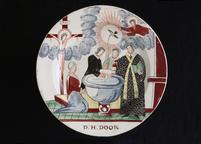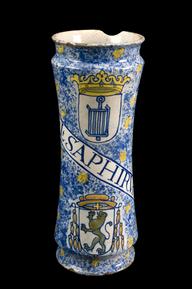





Italian syrup jug, C19 north Italian polychrome maiolica, used for laurel oil or oil of bay
This blue and white syrup jug is painted with the inscription ‘Oleum Lauranum’. The inscription tells us the jug stored Oil of Bay. This combated ‘flatulent colics’ (abdominal pain due to trapped gas), and ‘hysteric complains and for allaying the pains consequent upon delivery’ (childbirth).
The jug is decorated with a spray of flowers and has two bearded men in place of handles. It is made of a fine kind of Italian tin-glazed earthenware known as ‘maiolica’. This was introduced into Italy in the 1300s and the name is derived from the island of Mallorca. Maiolica particularly flourished throughout the 1500s and 1600s. Jugs like this were widely used by pharmacists and apothecaries to store preparations.
Details
- Category:
- Medical Ceramic-ware
- Collection:
- Sir Henry Wellcome's Museum Collection
- Object Number:
- A112526
- Materials:
- whole, pottery, polychrome maiolica
- Measurements:
-
overall: 220 mm x 140 mm
- type:
- syrup jar
- credit:
- Canney, V.




